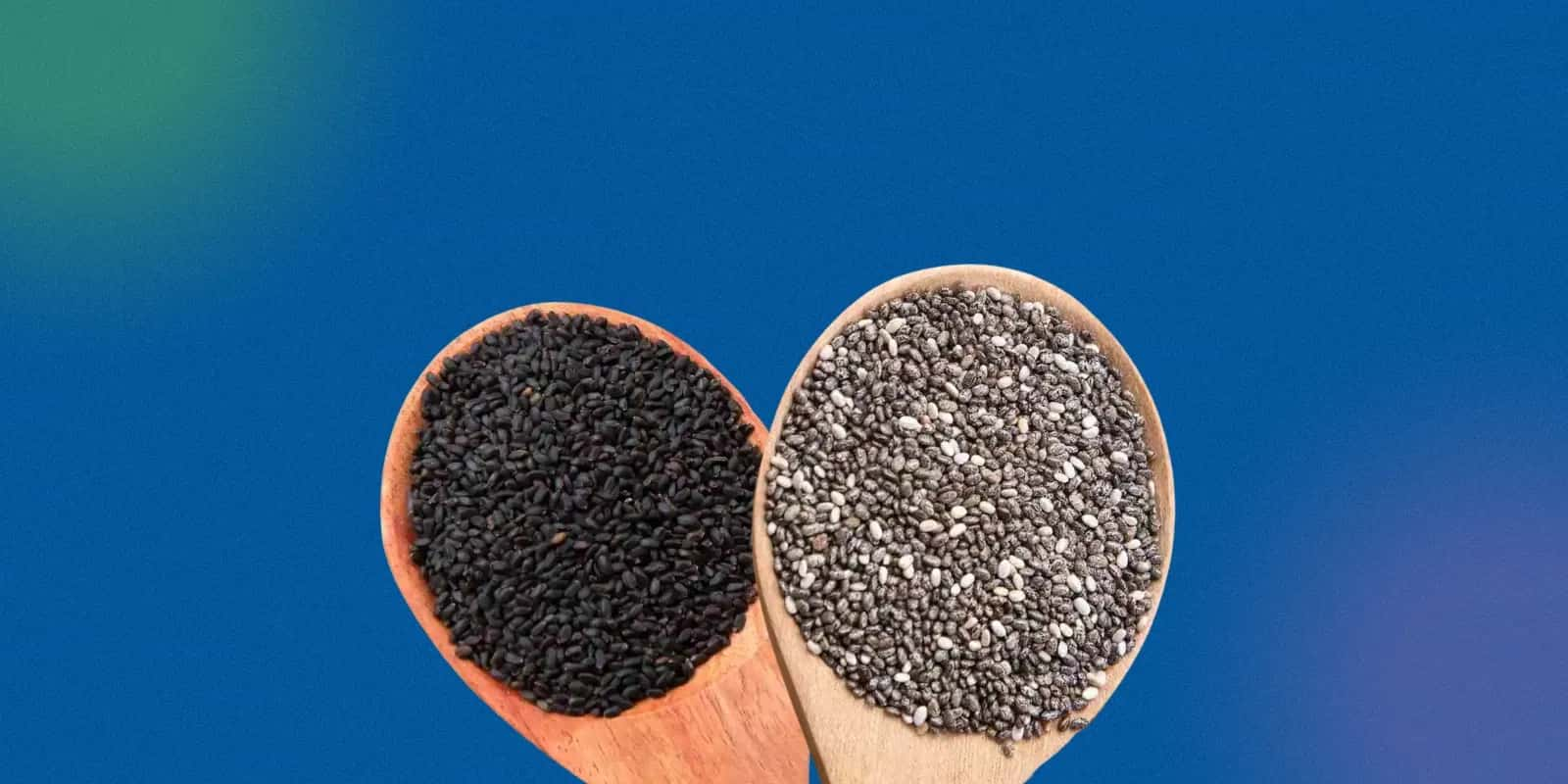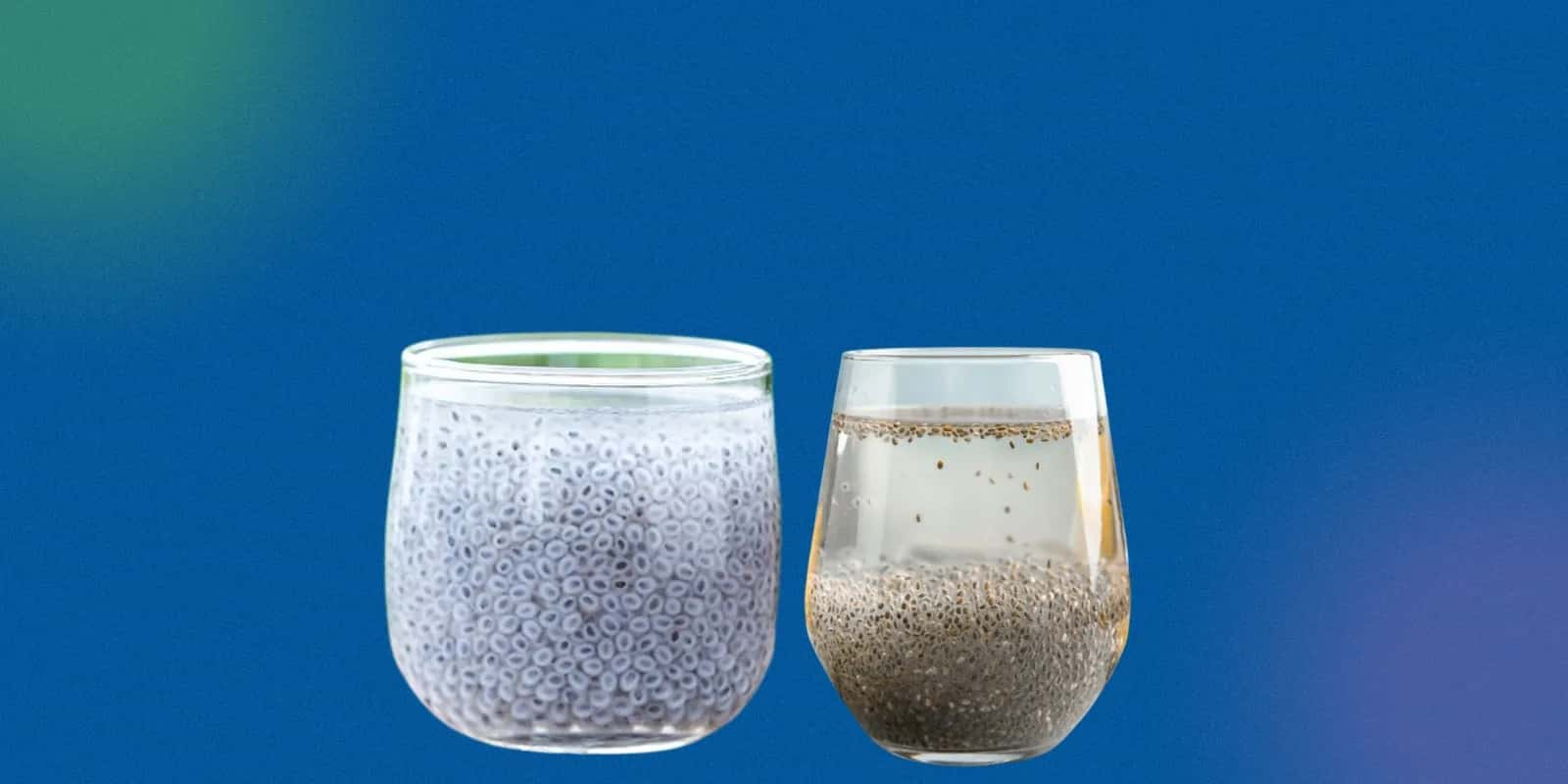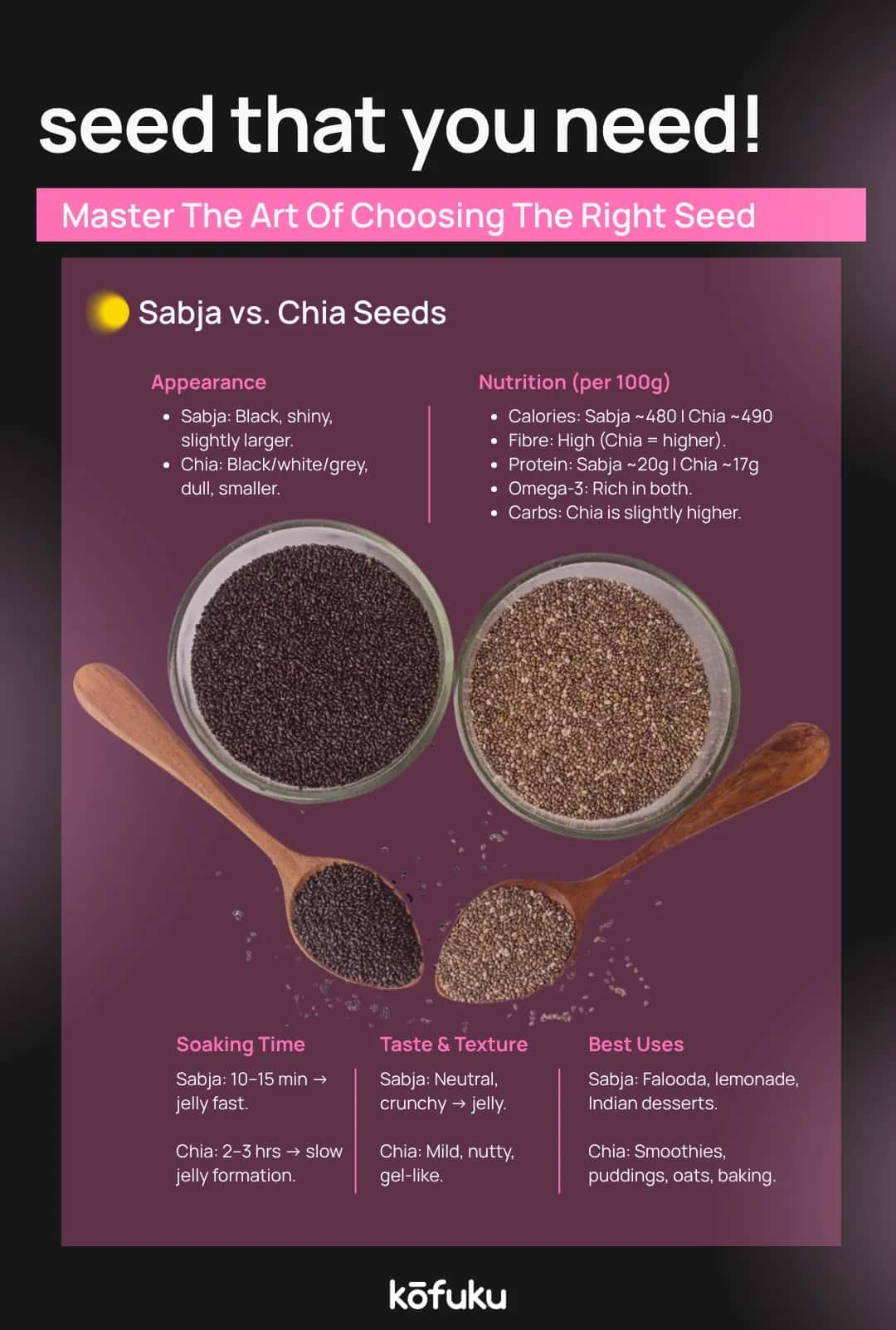Sabja Seeds vs Chia Seeds

Introduction
There’s a lot of confusion surrounding chia and sabja seeds. Admit it, there must have been times when you’ve used them interchangeably or been just plain confused as to what the difference between them is.
However, while both of these seeds share many similarities, they also have their differences in terms of origin, nutritional value, health benefits, and uses.
Many people ask, “Are chia seeds and sabja the same?” or “Which is better for my health goals?” In this article, you will understand the differences between chia seeds and sabja seeds.
By the end, you will have an understanding of the benefits of chia seeds vs sabja seeds, which will allow you to make an educated decision about what is best suited for your lifestyle and whether or not to incorporate both into your diet.
Difference Between Sabja Seeds vs Chia Seeds

Chia Seeds
Chia seeds come from the Salvia hispanica plant, native to parts of Mexico and Guatemala. They have been a food source for the Aztecs and Mayans for a very long time and were recognised for their endurance qualities and ability to provide sustained energy. Today, chia seeds are a modern superfood due to their nutritional richness.
Nutritional Value of Chia Seeds (Per 100g):
- Calories: 486 kcal
- Protein: 16.5 g
- Fat: 30.7 g
- Carbohydrates: 42.1 g
- Fibre: 34.4 g
- Calcium: 631 mg
- Magnesium: 335 mg
- Iron: 7.7 mg
- Omega-3 Fatty Acids: 17.83 g
The health benefits of chia seeds:
-
High in fibre: They are good for digestive health and help maintain a regular bowel movement.
-
High in omega-3 fatty acids: Good for heart health and reducing inflammation.
-
Weight control: Helps you feel fuller for a longer period, making it beneficial for weight loss.
-
Blood sugar control: Slower carbohydrate absorption, which reduces blood sugar spikes.
-
Bone health: They are high in calcium and magnesium, which are excellent for your bone health.
-
Heart health: Can help lower LDL cholesterol levels.
Chia seeds are versatile and can be added to smoothies, yoghurt, and even baked goods, as they absorb liquid and have a gel-like consistency.

Sabja Seeds
Sabja seeds, also known as Tukmaria seeds or falooda seeds, are the seeds of the sweet basil plant Ocimum basilicum. They are widely used in Indian and Southeast Asian cuisines and are most commonly found in refreshing summer drinks and desserts, like falooda.
Nutritional Value of Sabja Seeds (Per 100g):
- Calories: 442 kcal
- Protein: 15 g
- Fat: 14 g
- Carbohydrates: 63.80 g
- Fibre: 22.60 g
- Zinc: 1.58 mg
- Iron: 2.27 mg
- Magnesium: 31.5 mg
Health Benefits of Sabja Seeds:
-
Digestive Superfood: High in dietary fibre and helps relieve bloating and constipation.
-
Thermal Body Regulation: Sabja seeds were traditionally used in India during the summer to cool the body.
-
Weight Loss: The seeds expand in the stomach, making you feel full for longer.
-
Blood Sugar Control: These seeds can help balance blood sugar levels, which is beneficial for individuals with diabetes.
-
Detoxification: Sabja seeds aid in detoxifying your body.
-
Anti-Inflammatory: They contain compounds that help soothe inflammation.
Sabja seeds are best known for their use in drinks like falooda, lemon water, or sherbet, which are consumed after the seeds have been soaked.
Differences in Appearance and Texture
While both seeds tend to swell in size when soaked in water, they differ a fair amount when it comes to their appearance and texture.
When Soaked In Water
Chia Seeds: They take about 30 minutes to become thoroughly soaked and swell, producing a jelly-like coating with a smooth and gooey texture.
Sabja Seeds: Swell quickly within 5-10 minutes. They have a translucent outer layer and feel crunchier in the middle.
Uses:
Chia Seeds are mostly used in puddings, smoothies, yoghurt bowls, baked goods, or as a replacement for an egg in vegan baking.
Sabja Seeds can be added to drinks, desserts, or cooling summer recipes, such as falooda.
Taste of Soaked Seeds:
Chia Seeds: Mild, slightly nutty taste that mixes well with different ingredients.
Sabja Seeds: Almost flavourless but has a little basil-like aroma and gives a unique texture when bitten.

Conclusion
So, what are the differences between chia seeds and sabja seeds? While both of these seeds are nutritional powerhouses, the right one for you depends on the goals you are trying to achieve or the preparation you prefer.
Choose Chia Seeds If:
-
You would like to increase your intake of omega-3 fatty acids to promote heart health.
-
You want a neutral flavour to use in smoothies, porridge, or baked goods.
-
You want an energy-boosting nutrient all-in-one.
Choose Sabja Seeds If:
-
You want a seed that soaks quickly for an instant drink or dessert.
-
You want something that cools the body and provides relief to your digestive system.
-
You're looking for a natural remedy to alleviate bloating and constipation.
Many health-conscious individuals choose to incorporate both types of seeds into their diets. They might be different from each other, but when used together, they work as a nutritional powerhouse.

FAQs
Q. Which is best: Sabja seeds or Chia seeds?
A. It depends on what your health goals are. Chia seeds are higher in omega-3 fatty acids and protein, whereas sabja seeds provide relief in digestion faster and are an excellent choice for cooling your body.
Q. Who should not eat Sabja seeds?
A. People with low blood pressure or those taking blood thinners should consult a doctor before consuming sabja seeds.
Q. Can Chia and Sabja be taken together?
A. You can use both, but it is recommended that you soak them separately, as they have different soaking times and textures once soaked.
Q. Is Sabja good for weight loss?
A. Yes, sabja seeds will keep you fuller for a longer period and help reduce your overall caloric intake.
Q. Are Sabja seeds good for females?
A. Yes, they aid in digestion and can help alleviate bloating, cramps, and other menstrual-related issues.
Q. Can we soak Sabja seeds overnight?
A. You can, but it is not necessary, as they only need about 10 minutes to get thoroughly soaked.
Q. Are there any health benefits of Chia seeds?
A. Yes, they are high in omega-3 fatty acids, fibre, and antioxidants, which support heart, bone, and digestive health.
Q. Do Sabja seeds cause acne?
A. There is no clear evidence to prove that sabja seeds cause acne, so it may depend on the individual. However, they can be used to soothe the skin and alleviate inflammation.
Q. What are the side effects of drinking Sabja water daily?
A. Generally, sabja seeds are safe to consume, but you need to do so in moderation. Overconsumption can lead to bloating or excessive digestive discomfort.
Q. What is the difference between chia seeds and sabja seeds?
A. The significant difference between chia and sabja seeds lies in their origin, appearance, and nutritional value. Chia seeds belong to the plant Salvia Hispanica, native to Mexico.
On the other hand, sabja seeds belong to the sweet basil plant, which is native to both India and the Mediterranean area. Chia seeds are oval in shape & dull, and sabja seeds are elliptical and jet black in colour.
Q. Which seed is better for weight loss?
A. Both sabja and chia seeds are considered to be beneficial for a weight loss regimen as it include higher fibre content which, in turn, keeps you full for a longer duration.
Q. Can chia and sabja seeds be eaten daily?
A. Yes, one can consume both of these seeds daily. Nevertheless, it is crucial to soak these seeds separately in water before consuming them in any form.
Q. Do both seeds have the same nutritional value?
A. No, both these seeds differ in their nutritional content. Chia seeds are a good source of omega-3 fatty acids, protein, and fibre. On the other hand, sabja seeds are a great source of vitamins A, K, and C, as well as iron and potassium.
Q. How do you soak and consume chia vs sabja seeds?
A. For soaking chia seeds, mix them with water and let them sit for about 30 minutes. For sabja seeds, add water and set aside for around 10 minutes. Chia seeds take longer to soak than sabja seeds, so if you want to use them instantly, the latter might be a better option.

10 Food Items for the Hot and Humid Summer Months

Benefits of Coconut Sprouts: Nutrition in a Nutshell

Comprehensive Guide to Superfood Nutrition for Better Health

Not All Plant-Based Diets Are The Same: Junk Veggie Food And Its Impact On Health

Vitamin B12 Guide: Rich Food Sources, Deficiency Symptoms, and Hair & Weight Benefits


